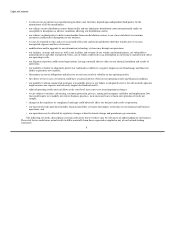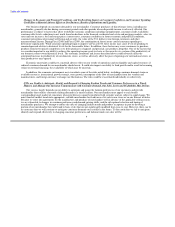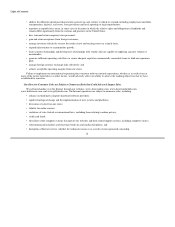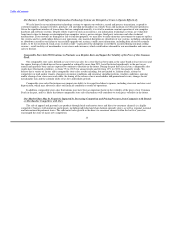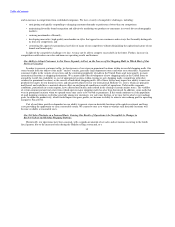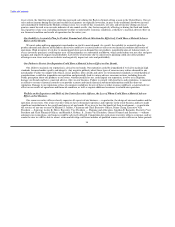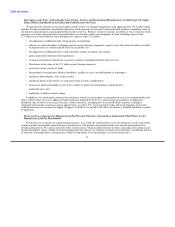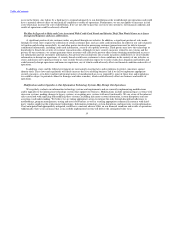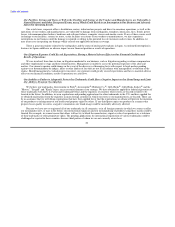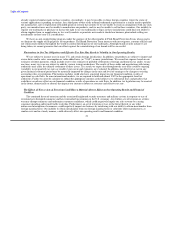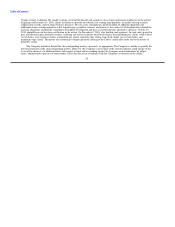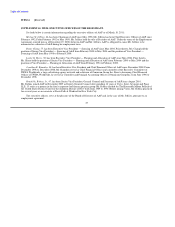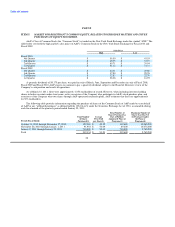Abercrombie & Fitch 2010 Annual Report Download - page 21
Download and view the complete annual report
Please find page 21 of the 2010 Abercrombie & Fitch annual report below. You can navigate through the pages in the report by either clicking on the pages listed below, or by using the keyword search tool below to find specific information within the annual report.
Table of Contents
meet our quality standards. A manufacturer's inability to ship orders in a timely manner or meet our quality standards could cause
delays in responding to consumer demands and negatively affect consumer confidence in the quality and value of our brands or
negatively impact our competitive position, any of which could have a material adverse effect on our financial condition and results of
operations. We are also susceptible to increases in sourcing costs from our manufacturers which we may not be able to pass on to our
customers and could adversely affect our financial condition or results of operations.
Additionally, while we utilize third-party compliance auditors to visit and monitor the operations of our manufacturers, we do
not have control of the independent manufacturers or their labor practices. As a result, the risk remains that one or more of our
manufacturers will not adhere to our global compliance standards and violate labor laws or other laws, including consumer and
product safety laws. Non-governmental organizations might attempt to create an unfavorable impression of our sourcing practices or
the practices of some of our vendors or manufacturers that could harm our image. If either of these events occur, we could lose
customer goodwill and favorable brand recognition.
Our Reliance on Two Distribution Centers Domestically and One Third-Party Distribution Center Internationally Makes us
Susceptible to Disruptions or Adverse Conditions Affecting Our Distribution Centers.
Our two distribution centers located in New Albany, Ohio, manage the receipt, storage, sorting, packing and distribution of
merchandise to our stores and direct-to-consumer customers, both regionally and internationally. We also use a third-party distribution
center in the Netherlands for the distribution of merchandise delivered to our stores located outside of North America. As a result, our
operations are susceptible to local and regional factors, such as system failures, accidents, economic and weather conditions, natural
disasters, and demographic and population changes, as well as other unforeseen events and circumstances. If our distribution
operations were disrupted, our ability to replace inventory in our stores and process direct-to-consumer orders could be interrupted and
sales could be negatively impacted.
We are in the process of consolidating our two distribution centers in New Albany into one, with an expected completion date in
mid-2012. This consolidation requires management's focus and attention, as well as significant capital investments. We believe that
this consolidation will result in operational efficiencies and that one distribution center in New Albany is adequate. However, if we are
unable to operate effectively with one distribution center, our distribution operations could be disrupted. Further, consolidation into
one distribution center increases our susceptibility to risks associated with system failures, accidents, weather conditions, national
disasters, and other unforeseen circumstances. If our operations are disrupted, our ability to replace inventory in our stores and process
direct-to-consumer orders could be interrupted and sales could be negatively impacted.
Our Reliance on Third Parties to Deliver Merchandise From Our Distribution Centers to Our Stores and Direct-to-Consumer
Customers Could Result in Disruptions to Our Business.
The efficient operations of our stores and direct-to-consumer operations depend on the timely receipt of merchandise from our
distribution centers. We deliver our merchandise to our stores and direct-to-consumer customers using independent third parties. We
use primarily one contract carrier for domestic store deliveries and all direct-to-consumer deliveries and a separate contract carrier for
international store deliveries. The independent third parties employ personnel that may be represented by labor unions. Disruptions in
the delivery of merchandise or work stoppages by employees or contractors of any of these third parties could delay the timely receipt
of merchandise. There can be no assurance that such stoppages or disruptions will not
18


